Modelling the checkpoint response to telomere uncapping in budding yeast
- PMID: 17015293
- PMCID: PMC2358953
- DOI: 10.1098/rsif.2006.0148
Modelling the checkpoint response to telomere uncapping in budding yeast
Abstract
One of the DNA damage-response mechanisms in budding yeast is temporary cell-cycle arrest while DNA repair takes place. The DNA damage response requires the coordinated interaction between DNA repair and checkpoint pathways. Telomeres of budding yeast are capped by the Cdc13 complex. In the temperature-sensitive cdc13-1 strain, telomeres are unprotected over a specific temperature range leading to activation of the DNA damage response and subsequently cell-cycle arrest. Inactivation of cdc13-1 results in the generation of long regions of single-stranded DNA (ssDNA) and is affected by the activity of various checkpoint proteins and nucleases. This paper describes a mathematical model of how uncapped telomeres in budding yeast initiate the checkpoint pathway leading to cell-cycle arrest. The model was encoded in the Systems Biology Markup Language (SBML) and simulated using the stochastic simulation system Biology of Ageing e-Science Integration and Simulation (BASIS). Each simulation follows the time course of one mother cell keeping track of the number of cell divisions, the level of activity of each of the checkpoint proteins, the activity of nucleases and the amount of ssDNA generated. The model can be used to carry out a variety of in silico experiments in which different genes are knocked out and the results of simulation are compared to experimental data. Possible extensions to the model are also discussed.
Figures
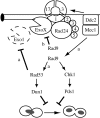
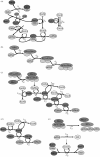



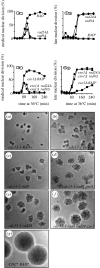

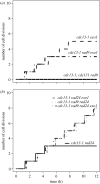
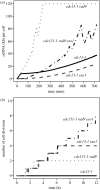

Similar articles
-
Exo1 and Rad24 differentially regulate generation of ssDNA at telomeres of Saccharomyces cerevisiae cdc13-1 mutants.Genetics. 2004 Sep;168(1):103-15. doi: 10.1534/genetics.104.027904. Genetics. 2004. PMID: 15454530 Free PMC article.
-
MRX protects telomeric DNA at uncapped telomeres of budding yeast cdc13-1 mutants.DNA Repair (Amst). 2006 Jul 13;5(7):840-51. doi: 10.1016/j.dnarep.2006.04.005. Epub 2006 Jun 12. DNA Repair (Amst). 2006. PMID: 16765654
-
EXO1-dependent single-stranded DNA at telomeres activates subsets of DNA damage and spindle checkpoint pathways in budding yeast yku70Delta mutants.Genes Dev. 2002 Aug 1;16(15):1919-33. doi: 10.1101/gad.225102. Genes Dev. 2002. PMID: 12154123 Free PMC article.
-
Hiding at the ends of yeast chromosomes: telomeres, nucleases and checkpoint pathways.J Cell Sci. 2003 Oct 15;116(Pt 20):4057-65. doi: 10.1242/jcs.00765. J Cell Sci. 2003. PMID: 12972499 Review.
-
Similarities and differences between "uncapped" telomeres and DNA double-strand breaks.Chromosoma. 2012 Apr;121(2):117-30. doi: 10.1007/s00412-011-0357-2. Epub 2011 Dec 28. Chromosoma. 2012. PMID: 22203190 Review.
Cited by
-
Stochastic modelling for quantitative description of heterogeneous biological systems.Nat Rev Genet. 2009 Feb;10(2):122-33. doi: 10.1038/nrg2509. Nat Rev Genet. 2009. PMID: 19139763 Review.
-
Annotation of SBML models through rule-based semantic integration.J Biomed Semantics. 2010 Jun 22;1 Suppl 1(Suppl 1):S3. doi: 10.1186/2041-1480-1-S1-S3. J Biomed Semantics. 2010. PMID: 20626923 Free PMC article.
-
Integrating systems biology models and biomedical ontologies.BMC Syst Biol. 2011 Aug 11;5:124. doi: 10.1186/1752-0509-5-124. BMC Syst Biol. 2011. PMID: 21835028 Free PMC article.
-
Taming the tiger by the tail: modulation of DNA damage responses by telomeres.EMBO J. 2009 Aug 5;28(15):2174-87. doi: 10.1038/emboj.2009.176. Epub 2009 Jul 23. EMBO J. 2009. PMID: 19629039 Free PMC article. Review.
References
-
- Foster S.S, Zubko M.K, Guillard S, Lydall D. MRX protects telomeric DNA at uncapped telomeres of budding yeast cdc13-1 mutants. DNA Repair. 2006;5:840–851. - PubMed
Publication types
MeSH terms
Substances
Grants and funding
LinkOut - more resources
Full Text Sources
Molecular Biology Databases

